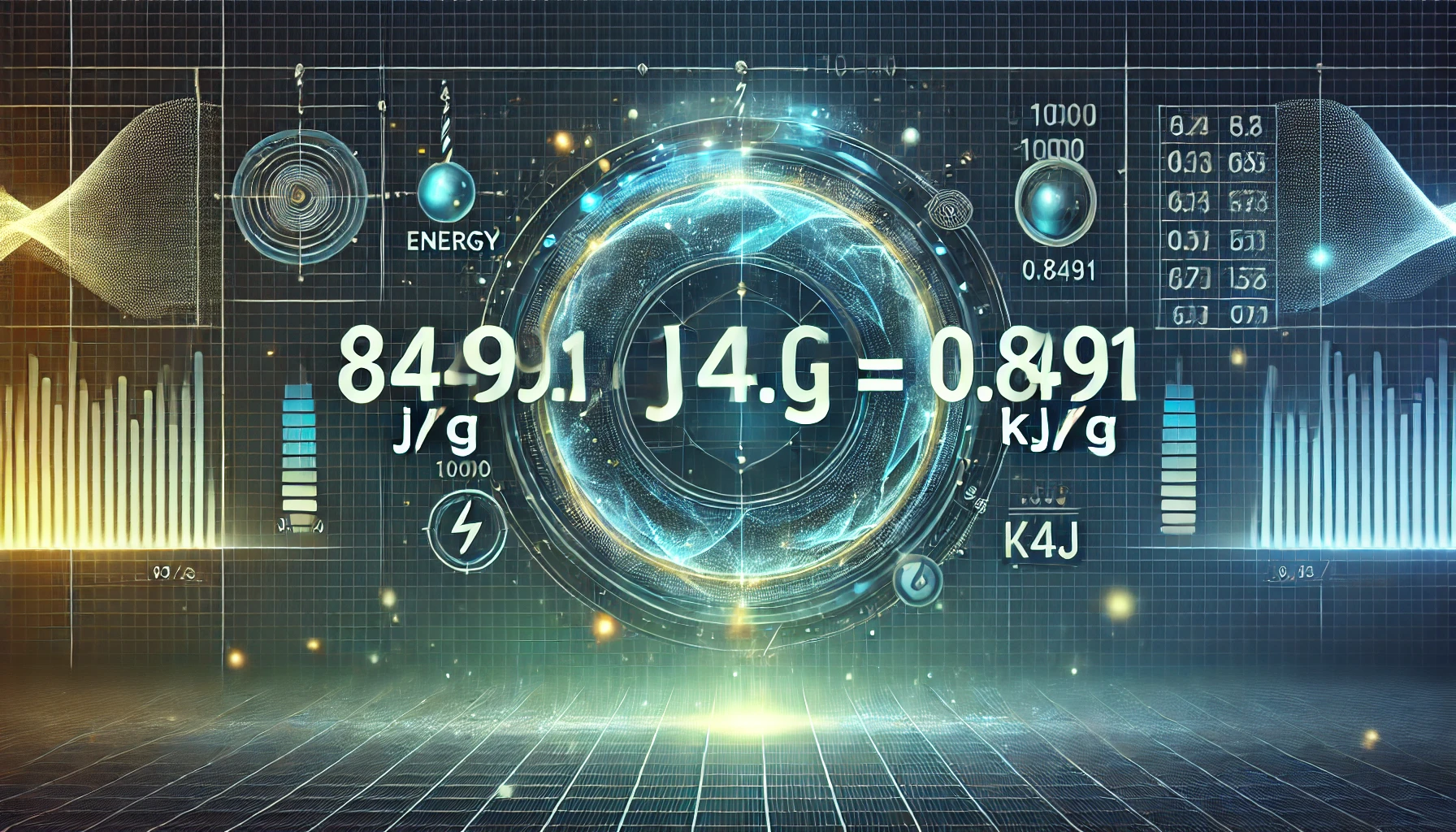What Does 849.1j/g to kj/g Mean?
At its core, the phrase 849.1j/g to kj/g refers to converting the amount of energy measured in joules per gram (j/g) into kilojoules per gram (kj/g). This process is essential in fields such as physics, chemistry, and engineering where energy efficiency, heat calculations, and material properties are studied.
- Joules (J): A standard SI unit of energy, joules quantify the amount of energy transferred or used.
- Kilojoules (kJ): Another SI unit, kilojoules, equals 1,000 joules. This makes it convenient for expressing larger amounts of energy.
For example, converting 849.1j/g into kj/g allows researchers and engineers to work with manageable numerical values while preserving precision.
How to Perform the Conversion?
The conversion between j/g and kj/g is simple because the relationship between joules and kilojoules is linear. To convert joules per gram into kilojoules per gram:
Conversion Formula
Energy (kJ/g)=Energy (J/g)÷1000\text{Energy (kJ/g)} = \text{Energy (J/g)} \div 1000
By applying this formula:
849.1 J/g÷1000=0.8491 kJ/g849.1 \, \text{J/g} \div 1000 = 0.8491 \, \text{kJ/g}
So, 849.1j/g = 0.8491kj/g.
Why Is This Conversion Important?
1. Scientific Applications
The j/g to kj/g conversion is widely used in laboratories and research institutions. It simplifies calculations for experiments involving heat energy, specific heat capacity, and material properties.
2. Industrial Use
Industries like food processing, where caloric values are determined in energy units, rely heavily on such conversions to standardize data.
3. Thermodynamics and Physics
In thermodynamics, energy efficiency and transfer rates often require converting smaller units (joules) into more practical ones (kilojoules) for complex system analysis.
Understanding Energy Units
What Are Joules?
Joules represent the energy transferred when a force of one newton moves an object one meter. This unit is foundational in physics, enabling precise measurement of energy and work.
What Are Kilojoules?
Kilojoules scale up the measurement of energy. Commonly, kilojoules are used in fields like nutrition (caloric values) and thermodynamics, providing a manageable metric for larger energy quantities.
Detailed Steps to Convert 849.1j/g to kj/g
Let’s break it down:
- Step 1: Write the Given Value
Start with the energy value in joules per gram: 849.1j/g. - Step 2: Apply the Conversion Factor
Divide the joules value by 1,000 to convert it into kilojoules:849.1 J/g÷1000=0.8491 kJ/g849.1 \, \text{J/g} \div 1000 = 0.8491 \, \text{kJ/g}
- Step 3: Finalize the Result
The result, 0.8491 kJ/g, represents the equivalent energy in kilojoules per gram.
Practical Examples
Example 1: Laboratory Application
Suppose you are measuring the heat energy of a chemical reaction, and the value is recorded as 849.1j/g. By converting this to kj/g, you can easily compare it with other reactions.
Example 2: Food Energy Content
Food manufacturers often express energy content in kilojoules per gram. For a food item with an energy value of 849.1j/g, the equivalent value is 0.8491kj/g.
Key Benefits of Using Kilojoules over Joules
- Simplifies Larger Values: Kilojoules reduce the complexity of handling large numerical data.
- Standardized Reporting: Many international standards prefer kilojoules for consistency.
- Improves Readability: A kilojoule is more intuitive for interpreting energy on a practical scale.
Common Misconceptions About 849.1j/g to kj/g
Misconception 1: It’s a Complex Process
Contrary to belief, converting joules to kilojoules is straightforward using the division method.
Misconception 2: Units Don’t Matter
Choosing the right unit (j/g vs. kj/g) impacts clarity and precision in calculations and reports.
Applications Across Fields
1. Energy Efficiency
Converting energy units helps evaluate efficiency in systems like engines and appliances.
2. Environmental Studies
Joules and kilojoules are crucial in understanding energy transfer in ecosystems and climate studies.
3. Material Science
Energy values in joules per gram are vital for studying material properties like specific heat and thermal conductivity.
FAQs
What is the quickest way to convert 849.1j/g to kj/g?
Divide the joules value by 1,000. The result will be in kilojoules per gram.
Why is this conversion important in food science?
It standardizes energy values for nutritional labeling and analysis.
How accurate is the conversion process?
Since the relationship between joules and kilojoules is linear, the conversion is exact and reliable.
Is there any software to automate such conversions?
Yes, tools like Excel or online calculators can instantly convert values.
Can this conversion be reversed?
Absolutely! Multiply kilojoules per gram by 1,000 to revert to joules per gram.
Is it necessary to use kilojoules in thermodynamics?
While not mandatory, kilojoules simplify complex equations and enhance clarity.
Conclusion
Understanding and converting 849.1j/g to kj/g is a fundamental skill in various scientific and industrial fields. The simplicity of the conversion formula makes it accessible for professionals and students alike. From enhancing energy efficiency to enabling standardized reporting, this process is indispensable for accurate data representation. As energy studies continue to evolve, mastering such conversions will remain a cornerstone of scientific and technical excellence.

Leave a Reply